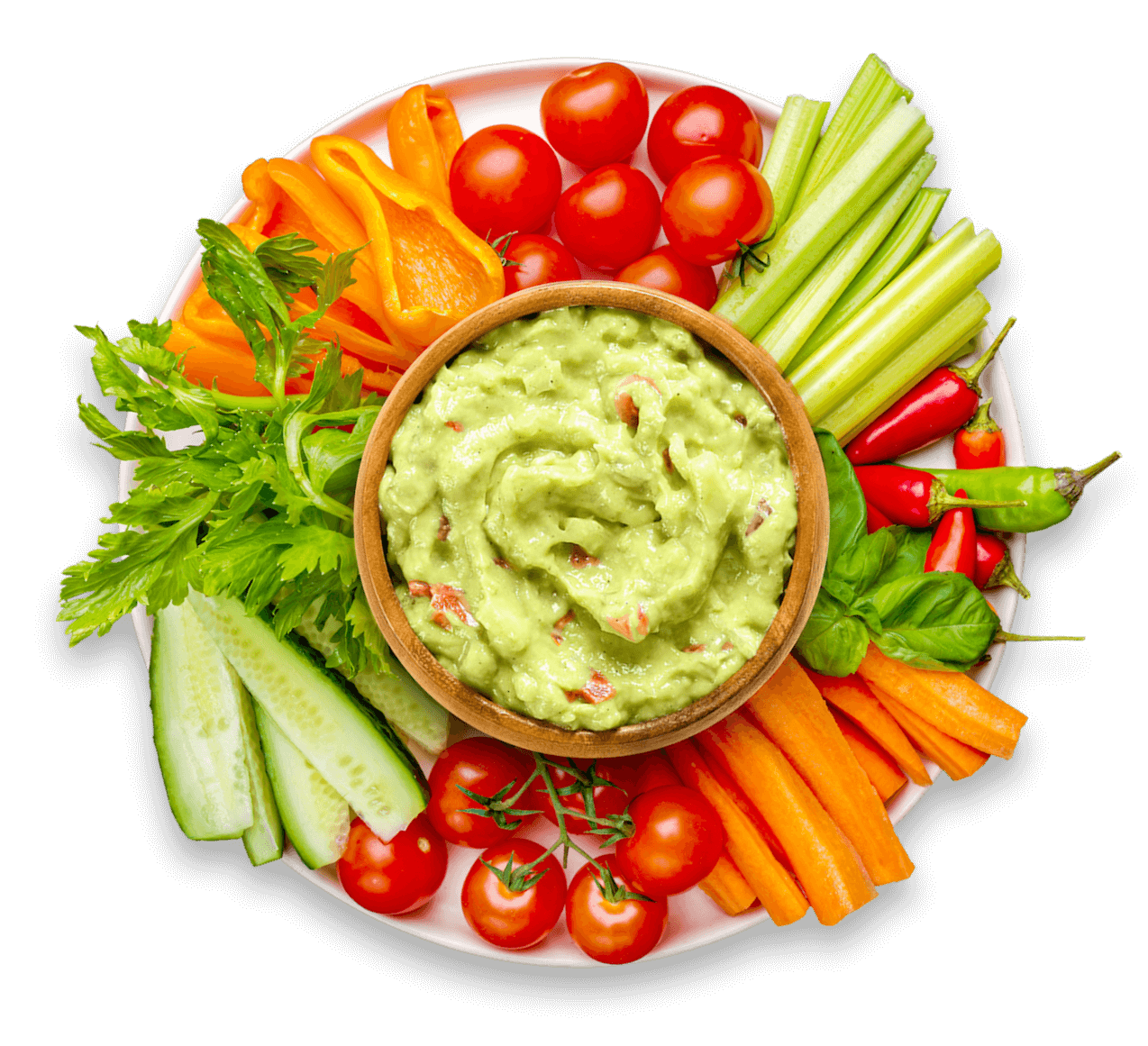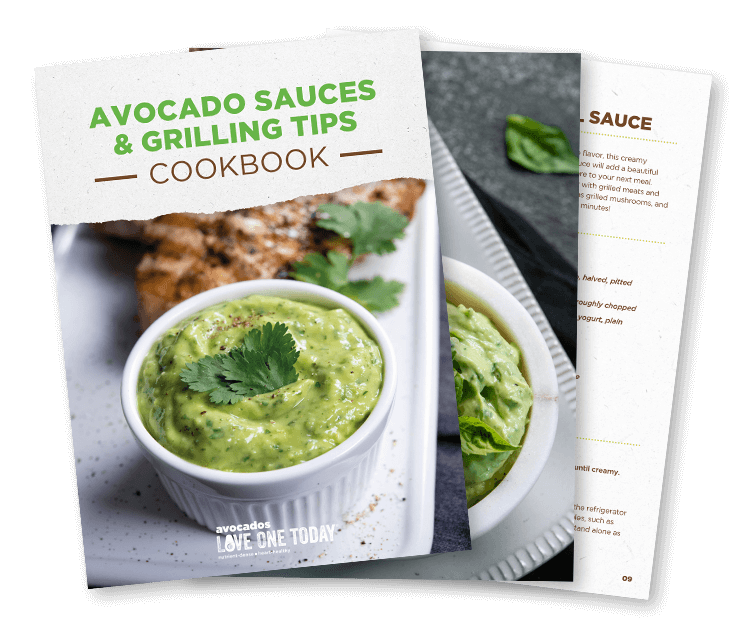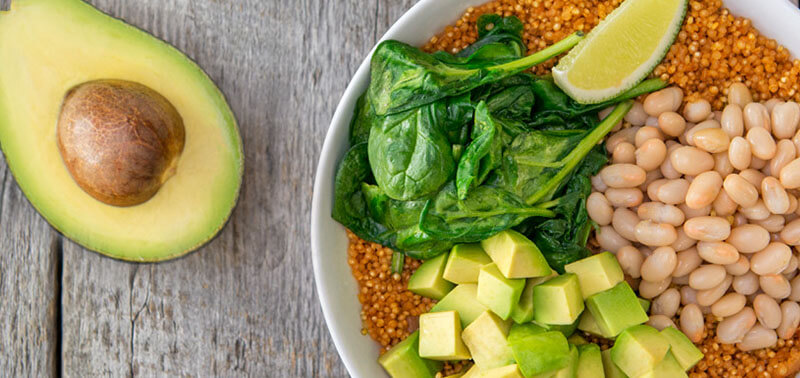Top 10 Avocado Sauces and Dips
Avocado sauces and dips have quickly become culinary staples, capturing the hearts and taste buds of professional recipe makers and home cooks. You can make avocado sauces and dips for various dishes—Mediterranean, Mexican, vegan—the list goes on! In addition, avocado sauces can provide a nutritious twist to any snack or meal.
For example, one serving of avocado, about one-third of a medium-sized avocado, has 3 grams of fiber, almost 20 essential vitamins and minerals, and 5 grams of unsaturated fats. These fats serve as a better alternative to saturated fat-rich sauces and dips. As such, they’re an excellent alternative for anyone aiming to reduce the amount of unsaturated fats and increase the amount of fiber and vitamins in their diet.
Because of these benefits, we’ve curated a list of our avocado sauces. We’ll discuss our recommendations for dishes to serve them with, how to make them, and other fun facts. From here, you’ll have the perfect addition, whether making dinner, a side salad, or looking for a fun dip to bring to any party!

Avocado Sauce Best Practices
Crafting the perfect avocado sauce requires attention to detail and a few best practices to ensure the best flavor and texture. Here are some essential tips to guide you through the process.
How To Select the Right Avocado
The most crucial tip when picking the right avocado is to know what a ripe avocado looks and feels like. A ripe avocado will yield slightly when you gently press on it and will look black with a slight green tinge on the outside. If it gives in too much after being pressed or is bruised, it may be overripe. An underripe avocado will be hard and taste a bit sour. Overripe avocados will be brown on the inside and taste rotten.
How To Prepare Your Avocado
Most avocado sauces require you to pit, slice, and mash an avocado. When removing the pit, cut it lengthwise around the seed with a sharp knife. Twist the halves apart, then gently tap the seed with the knife to lodge it into the seed. Then, twist the knife to remove the seed and scoop the flesh with a spoon. Alternatively, you can use a spoon or a fork to gently push the seed out from the back of the avocado half, or cut the avocado in wedges and remove the pit with your hand.
You can mash the flesh from here with a fork, potato masher, or blender. A fork or a masher will provide a chunky texture, whereas a blender or a food processor can provide a creamier, smoother texture. Ultimately, your choice will depend on the recipe and texture you’re aiming for.

You also don’t have to rely entirely on any recipe if you have a particular preference for the taste, flavor, or texture of the avocado sauce. That said, here are some tips to keep in mind:
![]()
Combine ingredients gradually:
When adding other ingredients such as lime juice, salt, garlic, or herbs, do so gradually. This allows you to adjust the flavors to your liking and prevents overpowering the delicate taste of the avocado.
![]()
Use fresh ingredients:
Fresh lime or lemon juice can enhance the flavor and prevent browning. Fresh herbs like cilantro or basil add a vibrant touch, while freshly minced garlic or shallots offer a subtle depth of flavor.
![]()
Balance acidity and seasoning:
Most avocado sauces require an acidic ingredient like lime or lemon to add tanginess. For some heat, you should also consider seasoning with salt and pepper and a touch of spice with chili flakes or jalapeño.
Ultimately, have fun! Be adventurous when trying new flavors with your avocado sauces.
Storing Avocado Sauce
Often, you’ll have plenty of leftovers after preparing and using an avocado sauce. Preserving it is the best way to enjoy it long-term. To prevent it from browning, you can add lemon or lime. After that, minimize as much air exposure as possible by storing your avocado sauce in an airtight container and storing it in a refrigerator. From here, you can enjoy your sauce for up to three days afterward. If it does brown at this time, don’t worry! You can always scrape the top layer before serving.
Following these best practices ensures that your avocado sauces are always creamy, flavorful, and visually appealing. With that in mind, let’s look at some of our favorite avocado sauces and dips, and how to make them!
Recipe for Simple Avocado Sauce
Whether you’re looking for a creamy sauce to pair with your sandwich or a dip for your veggies, this simple avocado sauce can be the perfect addition. You can pair it with various grilled vegetables and meats or as a simple spread for a nutritious twist to any sandwich. This recipe creates up to 8 servings if you use two tablespoons per serving. Each serving provides:
- 32 calories;
- 3 grams of fat;
- 1 milligram of sodium;
- 2 grams of carbohydrates;
- 1.5 grams of fiber;
- Less than 1 gram of protein.
Due to its simplicity, this recipe is one of the less calorically dense sauces featured on our list, and it tastes delicious!
Ingredients
- 1 ripe, fresh avocado, halved, pitted and peeled
- Juice of 1 lemon
- Zest of 1 lemon
- 3-4 Tbsp. water
- Salt and pepper to taste
Instructions
You can easily prepare this recipe in less than 10 minutes — perfect if you’re preparing your lunch for work. To make it, you’ll need to blend your avocado, lemon juice, and zest, and other ingredients in a food processor or blender. Add water until you get the consistency you want, season with salt and pepper to taste, and enjoy!
Recipe for Avocado Cream Sauce
This creamy avocado sauce can be the perfect base for a main entry like salmon cakes or chicken, moistening any protein. It’s also vegan, so don’t let the word “cream” scare you off. You can eat it if you’re eating a dairy-free, plant-based, or vegan diet. It only has 60 calories per serving, and provides:
- 5 grams total carbohydrates;
- 1 gram of protein;
- 3 grams of fiber;
- 1 gram of saturated fat;
- 6 grams of unsaturated fat;
- 0 grams of sugar;
- 150 milligrams of sodium.
The avocado provides most of the nutritional value in this recipe, making it a great source of healthy fats.
Ingredients
- 1 ripe, fresh avocado, halved, pitted, peeled and chopped
- 1 (14-ounce) can sliced new potatoes, drained
- 2 Tbsp. vegetable oil
- 2 Tbsp. cilantro, chopped
- 1 Tbsp. lime juice
- 1/4 tsp. salt
- 1/8 tsp. pepper
Instructions
To make the sauce, puree the avocado and other ingredients in a food processor or a blender. Once smooth, taste and add as much seasoning as you like.
Recipe for Avocado Crema
Like the avocado cream sauce, this avocado crema can serve as a creamy base for any main dish. You can also use it as a dip or salad dressing to pair it with a side dish. Unlike the avocado cream sauce, this crema has Greek yogurt, so it isn’t dairy-free. However, this addition makes the sauce extra creamy and adds protein to an already robust avocado cream sauce. This sauce is also milder, so it’ll be perfect to serve to a large crowd looking for less spice.
Altogether, this recipe creates four servings, but you can adjust as necessary depending on how many servings you need. It has the following nutritional facts for each serving:
- 90 calories;
- 7 grams of fat;
- 150 milligrams of sodium;
- 5 grams of carbohydrates;;
- 3 grams of fiber;
- 1 gram of sugar;
- 2 grams of protein.
Due to the addition of Greek yogurt, this sauce can be a bit more filling than other basic avocado sauces, adding more protein to any snack or meal.
Ingredients
- 1 ripe, fresh avocado, halved, pitted, peeled and mashed
- 2 Tbsp. plain fat-free Greek yogurt
- 1 Tbsp. fresh lime juice
- 1/4 tsp. salt
Instructions
To make the avocado crema, combine the mashed avocado with the lime and Greek yogurt in a large bowl, and season to taste. Afterward, store it in the refrigerator and serve it whenever you like.
Recipe for Creamy Vegan Avocado Queso Verde
If you’re looking for a dip for chips, veggies, or tacos, look no further than this creamy vegan avocado queso verde recipe. You heard that right: creamy and with queso yet vegan! Instead of using a dairy-based ingredient to make it thick, this recipe uses cashews and a dairy-free alternative like almond and oat milk. This dip is also incredibly vibrant, with plenty of seasonings and additions like jalapeños to give it flavor. Our recipe provides 12 servings, making it perfect for any party, but you can adjust as necessary. In each serving, this queso verde provides:
- 110 calories;
- 9 grams of fat;
- 220 milligrams of sodium;
- 7 grams of carbohydrates;
- 2 grams of fiber;
- 4 grams of protein.
Thanks to the cashews and avocado, this recipe has plenty of protein compared to other dips, plus healthy fats to fill you up.
Ingredients
- 2 ripe, fresh avocados, halved, pitted, and peeled
- 1 cup raw cashews
- 2-3 cups of water (for soaking)
- 1 1/2 cups plain oat milk, (may substitute with almond milk)
- 1/2 cup lightly packed fresh cilantro leaves
- 1 fresh jalapeño pepper, seeded and sliced
- 1/4 cup nutritional yeast (found in health food section of grocery store)
- 1 Tbsp. lemon juice
- 1 tsp. garlic powder
- 1/2 tsp. onion powder
- 1 tsp. salt
- 1/2 tsp. ground black pepper
Instructions
First, soak your cashews in a couple of cups of boiling water and let them sit away from the heat source for 15 minutes. You can also soak cashews with room-temperature water overnight to provide the same results. Then, blend your softened cashews and the rest of your ingredients in a food processor or a blender. Transfer this mix into a saucepan to make it warm and thicken up a little. Afterward, you’ll let the queso verde cool and serve when ready!
Recipe for Avocado Basil Dipping Sauce
If you’re making a dish with an Italian or Mediterranean twist, like cauliflower tots, this dip can be the perfect addition with its fragrant taste of basil leaves. In this recipe, you’ll have four servings with the following nutritional facts for each serving:
- 110 calories;
- 6 grams of carbohydrates;
- 4 grams of protein;
- 8 grams of total fat;
- 3 grams of fiber;
- 2 grams of sugar;
- 85 milligrams of sodium.
This recipe has less sodium than most of the featured recipes, which will serve as a perfect addition for anyone trying to minimize their salt intake.
Ingredients
- 1 ripe, fresh avocado, halved, pitted and peeled
- 1/4 cup nonfat Greek yogurt, plain
- 1 Tbsp. olive oil
- 1/2 cup basil leaves, roughly chopped
- Juice of 1 lemon
- Zest of 1 lemon
- Salt and pepper to taste
Instructions
To make this dip, you’ll need to halve, pit, and peel the avocado, chop the basil, and puree the other ingredients in a blender or a food processor until smooth. From here, you can add additional seasonings as you see fit and serve!
Recipe for Avocado Chimichurri Sauce
Chimichurri sauce is the perfect Latin twist to any dish, especially if you want to use it as a marinade or a topper for grilled meat. Although most chimichurri sauces don’t include avocados, this recipe does, adding nutritional value with extra fiber, protein, and healthy fats. This recipe creates about eight servings with the following nutritional information:
- 70 calories;
- 7 grams of fat;
- 40 milligrams of sodium;
- 3 grams of carbohydrates;
- 2 grams of fiber;
- 1 gram of protein.
Each serving equates to two tablespoons, but you may feel inclined to enjoy more as you taste the delicious garlic and herb blend!
Ingredients
- 1 ripe, fresh avocado, halved, pitted and peeled
- 1/4 cup cilantro leaves, packed
- 1/4 cup Italian parsley leaves, packed
- 2-3 garlic cloves (1 tsp.), minced
- 2 Tbsp. red wine vinegar
- 2 Tbsp. olive oil
- Juice of 1 lime
- 3 Tbsp. water
- Salt and pepper to taste
Instructions
Like the other sauce recipes on this list, you’ll need to combine all the ingredients in a blender or food processor until creamy. If your blender has difficulty processing everything, you can always add water to loosen the sauce.
Recipe for Spicy and Creamy Avocado Sauce
If you like your food to be spicy, we’ve got the recipe for you! This spicy and creamy avocado sauce can be the perfect topper for any main dish, especially for any meat you’d prepare at a summer BBQ. In particular, you may enjoy this sauce to add nutritional value to your favorite fish tacos. This recipe makes about eight servings, with the following nutritional information for each serving:
- 70 calories;
- 7 grams of fat;
- 40 milligrams of sodium;
- 3 grams of carbohydrates;
- 2 grams of fiber;
- 1 gram of protein.
This sauce is nutritionally dense with its additional value of fiber and healthy fats, so it’ll be the perfect healthy alternative to any hot sauce you gravitate toward.
Ingredients
- 1 ripe, fresh avocado, halved, pitted and peeled
- 1/2 cup cilantro leaves, packed
- 2 Tbsp. olive oil
- 2 Tbsp. lime juice
- Zest of 1 lime
- 1 tsp. white wine vinegar
- 1 Tbsp. jalapeño, minced
- 1 clove garlic, minced
- 1/2 inch piece fresh ginger, minced
- Salt and pepper to taste
Instructions
After mincing the jalapeño, ginger, and garlic, you’ll place these ingredients and the other recipe ingredients in a blender and food processor until smooth, and add salt and pepper and other seasonings to taste.
Recipe for Tahini and Avocado Sauce
Tahini is already a nutritionally sound sauce with its combination of healthy fats and fiber from blended sesame seeds. However, you can add even more fiber with avocado, thus creating this tahini and avocado sauce. With it, you can create the best Middle Eastern and Mediterranean dishes, such as grilled lamb or even a simple salad dressing paired with a tangy tzatziki sauce. This recipe creates ten servings if you use two tablespoons for each serving. Each serving has the following nutritional value:
- 90 calories;
- 7 grams of fat;
- 35 milligrams of sodium;
- 3 grams of carbohydrates;
- 2 grams of fiber;
- 2 grams of protein.
Because of the sesame seeds, this sauce has more calories than the others; and it can be more filling as a result.
Ingredients
- 1 ripe, fresh avocado, halved, pitted and peeled
- 1/4 cup unsalted tahini (sesame seed paste)
- 1/4 cup nonfat Greek yogurt, plain
- Juice of 2 lemons
- Zest of 1 lemon
- 1 Tbsp. red wine vinegar
- 1 clove garlic, minced
- 1/2 tsp. ground cumin
- Salt and pepper to taste
- 1 tsp. sesame seeds, for garnish (optional)
- 1-2 Tbsp. water (optional)
Instructions
Once you gather your ingredients, place them in a blender or food processor and blend until the desired consistency. If you like your sauce to be more viscous or you’d like to use it as a dressing, you can add one or two tablespoons at a time and blend further. Avoid this step if you’d like your sauce to be thicker. You can also add more sesame seeds as a garnish on top.
Recipe for Guacamole
Guacamole is a classic for a reason. It’s a dip everyone gravitates toward at any table and can be just as spicy or mild as you’d like. Many guacamole recipes feature fun additions such as mango or jalapeño, but even the most basic guacamole recipe can captivate your taste buds. This recipe is the latter kind of guacamole: classic, versatile, and yummy. You can use it for dipping your veggies or chips, or you want to serve it on top of a main dish like enchiladas.
Our recipe can serve up to eight people and has the following nutritional facts per serving:
- 130 calories;
- 11 grams of fat;
- 10 milligrams of sodium;
- 9 grams of carbohydrates;
- 5 grams of fiber;
- 2 grams of protein.
This guacamole recipe is a good source of fiber — the more fiber you have in your diet, the better your digestive system will be.
Ingredients
- 4 ripe, fresh avocados, halved, pitted, peeled and cut in chunks
- 1 Tbsp. lemon juice
- 1/2 small sweet white onion, minced
- 1 ripe Roma tomato, seeded, diced
- salt and pepper (to taste)
Instructions
To make this recipe, remove the pit from the avocado, peel it, cut the flesh into chunks, and mash it. Then mince the onion, deseed the tomato, and dice it. Mix in these ingredients and add the seasonings for taste.
Recipe for Avocado Pesto Sauce
Pesto provides an Italian flavor to many salads, pastas, and main dishes. It’s typically made from parmesan, oil, pine nuts, basil, and various seasonings. Because of the parmesan, most pesto sauces aren’t vegan, plant-based, or dairy-free. However, this recipe is a great dairy-free and vegan alternative to pesto because it uses avocado and peas instead of parmesan to make the sauce just as creamy.
Our recipe serves up to four people and includes the following nutritional facts per serving:
- 160 calories;
- 10 grams of carbohydrates;
- 5 grams of protein.
- 12 grams of fat;
- 5 grams of fiber;
- 2 grams of sugar;
- 40 grams of sodium;
This recipe includes more grams of fiber and fewer calories than a traditional pesto recipe since it isn’t derived from a dairy base.
Ingredients
- 1/3 cup walnuts (chopped or in pieces)
- 1 ripe, fresh avocado, halved, pitted and peeled
- 4 garlic cloves
- 1/2 cup packed basil (about 1 oz.)
- 1 cup green peas, cooked from frozen
- 1/2 tsp. ground black pepper
Instructions
To make the pesto, cook the frozen peas according to the package directions and then add them with the other ingredients in a food processor or a blender. Pulse the ingredients until you can’t see the peas or the walnuts anymore. Add seasoning as you see fit and serve when ready.





